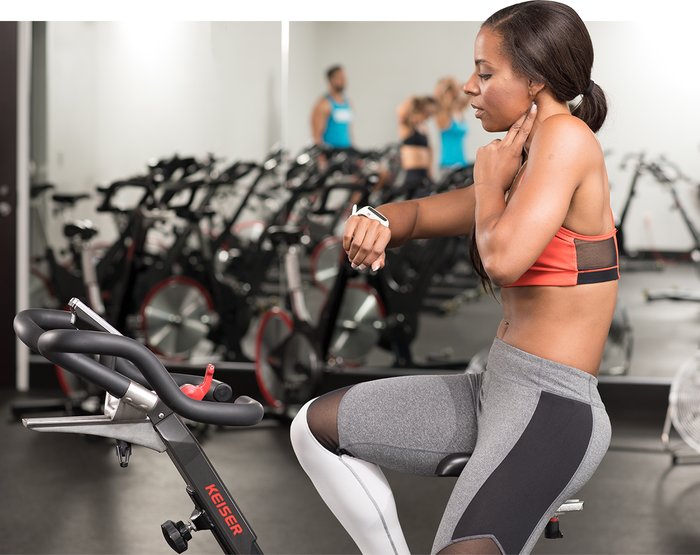It's great to be able to strap on a device that tells you your pulse, VO2 max, sleep efficiency, and blood sugar; your floors climbed, distance covered, and calories burned. But do all those numbers actually help you reach your fitness goals?
For many people, the numbers these devices spew out don't mean much. Finding ways to make fitness metrics make sense is creating new opportunities for consumers, trainers, and gyms.
Data Without Context is Just a Bunch of Numbers
Kerri McMaster is co-founder and chief strategy officer for New Zealand-based Performance Labs. Her company builds the artificial intelligence engines behind products that enable coaches, trainers, and athletes to provide actionable intelligence to athletes.
It's one thing, McMaster says, to look at your device and see you've run 10 miles and your heartbeat is 80 beats per minute. That's all useful information, she says, but what's missing is what she refers to as "context." Yes, you were running, but at what altitude? Were you running on flat ground or up a slope? Were you running at the proper cadence? How much power did your legs generate?

When you lift weights, it's important to track your sets, reps, and weight. What if your device could also track the trajectory and consistency of each lift from top to bottom? What if it could continually compare your current workout with past workouts? With this kind of contextual information, McMaster says, you could apply artificial intelligence to the data that would enable the device to not just track your workout, but to provide feedback that teaches you how to have a better workout.
"By combining information about the context of the workout with the right algorithm," she says, "it will be possible to create quick workout summaries coaches and trainers can use to provide feedback to the athlete in real time or immediately after a workout."
No Longer "Pie in the Sky" Thinking
Some companies, including Performance Labs' ARDA coaching platform, are already bringing this combination of sensors, devices, and software to market. Lumo Bodytech's Lumo Run combines smart sensors with software to track movement in real time and provide wearers with audio feedback to help them optimize running performance. Oakley's Radar Pace uses similar technology for both runners and cyclists, and XMetrics Pro collects in-water data to help swimmers generate the most power from each stroke. Many of these kinds of applications use the artificial intelligence coaching platform developed by ARDA.
"Many people think fitness metrics are something new, when in fact they're anything but," McMaster says. "Polar's first heart rate monitor was available about 30 years ago. In fact, our company has been in business for 25 years to make sense of fitness data collected as people exercise."
What is new these days, she says, is the size, portability, and kinds of metrics fitness sensors can capture. What is old, she adds, is trying to figure out how to collect better data and improve the way it's interpreted.
Your Personal Coach Is Waiting for You
McMaster says Performance Labs and ARDA are currently working on ways to integrate insight generated by AI-driven coaching into consumer products.
"Suppose you're out exercising and are wearing a wrist-based device," she says. "With truly intelligent devices, you'll have a digital coach following your numbers so closely that it can say, 'Whoa, you're running too fast, slow down,' or 'Your stride is not supporting your goals,' or that can motivate you to run farther or faster."
Taking it a step further, she says, the device can be integrated with other devices.
"As you walk into your house, your device automatically syncs with your smart speaker, which says to you, 'Hey, I see you've done your workout. Would you like me to show you your post-workout analytics? Then we can set up tomorrow's workout with some new things for you to try so you can improve your performance."
Performance Labs is currently working with Amazon to enable the Amazon Echo to provide this service.
"How the information is delivered depends on who our partners are and what kind of experience they want to create for their users," she says "The ultimate use of the data determines the kind of technologies we put together to gather, interpret, and deliver it."
New Opportunities for Trainers and Gyms
Fitness-metrics technology is also opening up new doors for personal trainers and gyms. For instance, one of the constant business challenges trainers face is how to grow their businesses.
"The average PT's problem is that there's only one of them, and they can generate only so much income if they have to be physically present with each client," McMaster explains. "But if all of the PT's clients' data is being collected and analyzed, now they can guide each client without having to be physically present beside them. Suddenly, they're able to scale the number of clients and grow their business."

The technology stands to benefit gyms in a similar way. Gyms that invest in sensor-device-software technology can attract trainers enticed by the prospect of ten-fold increases in their customer base. The gyms can also provide a version of the technology to consumers, transforming the gyms from a place where you exercise to a place where you get personalized digital feedback that optimizes your time on the treadmill or in the weight room.
Where Is Fitness Technology Headed?
On the micro scale, McMaster says, the fitness-data industry may soon evolve to the point where people choose devices not so much based on what each device can measure, but on the goals each person has set for themselves. Those goals could be anything, she says, from wanting to get fit to setting a new PR for the bench or a marathon.
"At the moment, most consumers enter a store and think to themselves, 'I have a goal and I'm going to buy a whatever help me get the dream.' So they buy some kind of tracker and it sort of feels interesting and exciting for a little while.
"But before long they're thinking, 'Okay, I'm doing ten thousand steps, now how do I lose those 10 pounds?' or 'I've been lifting for two months, so how do I increase my deadlift PR?' It won't be long before the salesperson will start by asking you your goal, then directing you to the right combination of sensors, device, and software to help you achieve it."
Looking further ahead, McMaster thinks about how the technology can be used to manage lifestyle-controllable diseases, or help people exercise in a way that helps them earn rebates on their health insurance or life insurance. She ponders how the technology could improve the way people rehabilitate after an injury or how elderly people can stay healthy and mobile, how obese adults can lose weight and how children can learn good exercise behavior.
"I think sensor technology is profoundly exciting because we're able to get more and more insights into how our bodies move," McMaster says. "Now, we need to get a little more granularity around these insights to really solve the consumer problem, which is, 'How do I achieve my goals?'"

